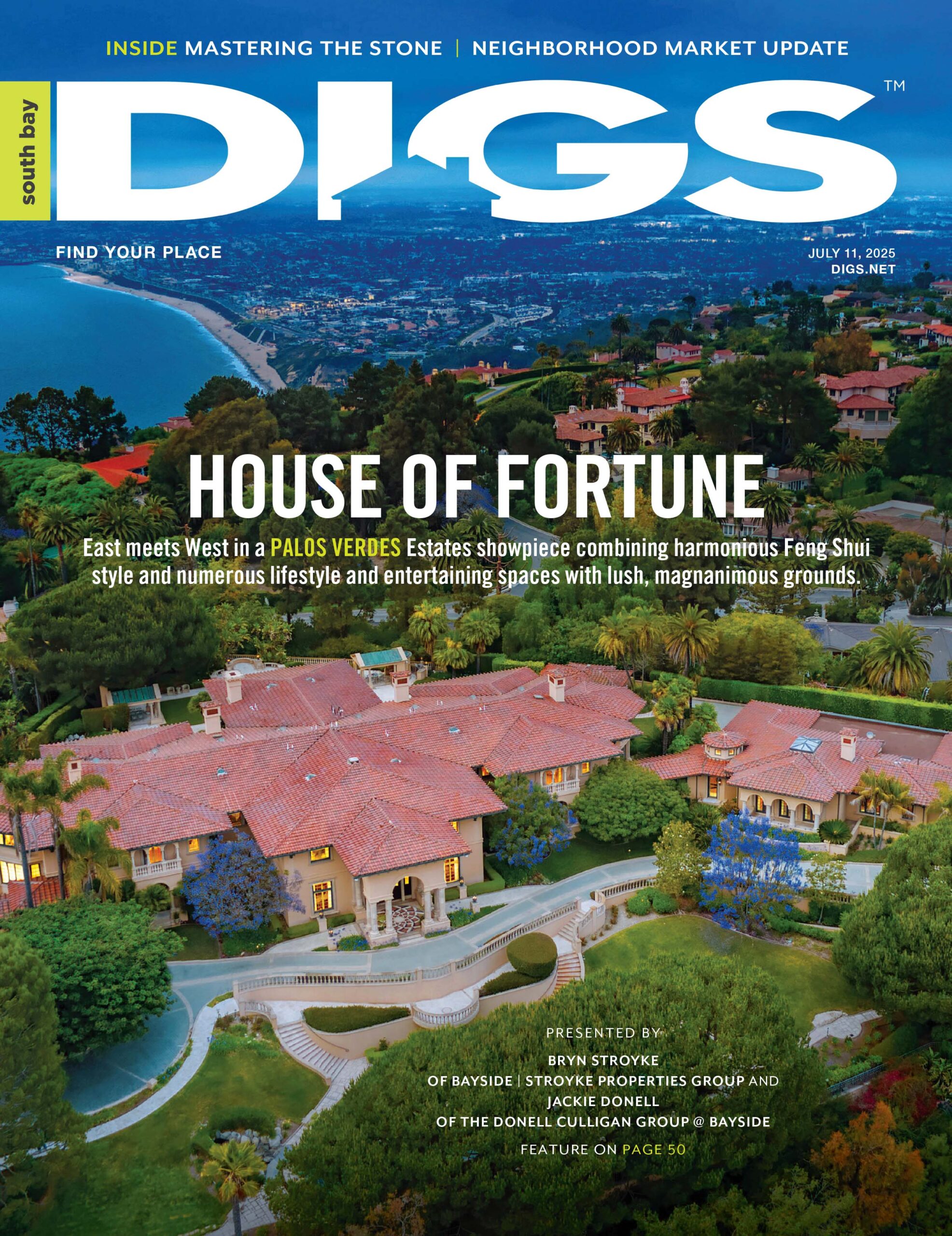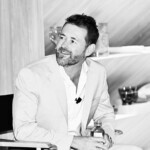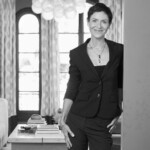Table of Contents
In this Episode
Join us for an in-depth conversation with Brian Pinkett, Principal of Landry Design Group, as he takes us through his 30-year journey with one of the most iconic architectural firms in the world. On this episode of Titans of Trade, Brian shares the firm’s secrets to growth, innovation, and longevity—transforming from a small team to a global powerhouse with over 50 designers working on groundbreaking residential projects across the globe.
Brian delves into the firm’s signature design philosophy, explaining how Landry Design Group seamlessly blends classical and modern architectural styles to create what they call “Hybrid” architecture. He recounts how the firm took on a project in Asia where the client requested a modern home that retained the timeless charm of Hôtel du Cap. Through a process of asking the right questions and careful analysis, they designed a stunning, castle-like estate spanning 230,000 square feet on a 30-acre property—a prime example of their ability to fuse tradition with innovation.
Beyond design, Brian gives us an inside look at the culture within the firm, where creativity thrives through collaboration. He highlights the importance of assembling teams that include not only talented architects but also top-tier contractors, interior designers, and artisans from around the world. This collective expertise allows Landry Design Group to meet the demanding expectations of high-net-worth clients, delivering unique and visionary homes that push the boundaries of what’s possible in architecture.
The discussion doesn’t stop there. Brian also explores the role of technology in the future of architecture, emphasizing the transformative power of AI. According to Brian, firms that harness AI will have a competitive edge, with the technology acting as a supercharged team member capable of enhancing creativity and efficiency. Yet even in this high-tech future, Brian underscores the enduring connection between architecture and nature, revealing how elements of the natural world—from the way sunlight filters through a space to how animals move around a property—are deeply integrated into his designs.
Whether you’re an architecture enthusiast, aspiring designer, or simply curious about how today’s top architects marry tradition and innovation, this episode offers an exclusive look behind the scenes of one of the world’s leading firms. Brian’s insights into leadership, design, and the future of architecture are not to be missed.
Tune in and discover how Landry Design Group continues to set the standard for luxury residential architecture worldwide.
Takeaways
- Landry Design Group specializes in blending modern and traditional styles in their architecture
- Collaboration is a key aspect of the firm’s culture and success
- Hybrid architecture combines the best elements of modern and traditional styles
- Personalized design is important to create unique and meaningful spaces for clients
- The integration of AI technology in architecture can enhance efficiency and speed up the design process
- Creating a positive work culture and providing mentorship opportunities are crucial for employee growth and satisfaction
- Balancing technology with organic inspiration is essential in architecture
- Brian Pinkett is passionate about animal welfare and runs a nonprofit animal sanctuary on his farm in San Diego
Quotes
- “We don’t have a signature style. It’s more about the clients and creating the architecture that they want to live in.”
- “Hybrid for us is a fusion between traditional and modern architecture, pulling out the best of both worlds.”
- “We love what we do. We love working with our clients, and the collaboration with the contractors and interior designers. It’s just so fun to explore new things. We’re so fortunate to have clients that are willing to stretch their imagination. A lot of them want things that are unique and exciting.”
- “We had a client who came and said, ‘I love Hôtel du Cap, but I want a modern house,’…So we looked at it and we said, ‘Well, what makes it so special? What is it that you love about it?’ And then we dissected that; we asked a lot of questions; and we came up with an interpretation on it that’s Modern.”
- “I have so many different interests that are all related. I see it all as being related—in the creativity and the collaboration, and the love and respect for other people and animals.”
- “In the future, there’s going to be two types of businesses: The ones that are using AI, and the ones that are out of business. It’s so powerful, and what’s great about it is it’s like having another employee who can work 10 times as fast. If you know how to utilize it, if you know how to give it the right direction and inputs, it can be very supportive.”
- “Talent is a commodity that is sometimes overlooked. The collaborations we have with interior designers and contractors, even the subcontractors—they’re at the highest level. We search them out far and wide, and when we’re doing projects overseas we’ll bring people in from other locations, other countries, in order to make it work.”
Follow Brian Pinkett
Website: landrydesigngroup.com
Instagram: instagram.com/landrydesigngroup/
LinkedIn: https://www.linkedin.com/in/brian-pinkett-aia-16b1a7132
Full Transcript
Constance (00:01)
Welcome to Titans of Trade. I am your host Constance Dunn and today we welcome a notable architect responsible for some very cutting edge and remarkable projects all over the world. Welcome Brian Pinkett.
Brian Pinkett (00:13)
Constance, thank you for having
Constance (00:14)
Yeah, absolutely. So many people listening will know Landry Design Group. One of the things they might not know about is something that I think is very distinctive about the firm. And that’s the fact that there is modern and traditional works. So the body of work, you guys really produce things that are very different and very faithful kind of to the idea of modern architecture, likewise, kind of traditional architecture. And I’m wondering
how from a capabilities perspective the firm’s able to do that so faithfully.
Brian Pinkett (00:48)
my goodness, great question. So at Landry Design Group, we don’t have a signature style. that’s, in some ways it’s good and a lot of architects don’t think it’s a great thing because they have their signature style that they want to continue to push. For us, it’s more about the clients and creating the architecture that they want to live in because we do homes.
Constance (01:11)
All
Brian Pinkett (01:17)
and homes are more personal and individual. So we’ve been able to develop our firm to be able to do modern work, traditional work, transitional work, and everything in between. And that’s what’s made it a lot of fun.
Constance (01:37)
And there’s something called hybrid architecture, hybrid design. That’s kind of a specialty and it means something very specific at the firm. And if you could just kind of share what that really means.
Brian Pinkett (01:49)
Well, hybrid for us is sort of a fusion between the traditional architecture and the modern architecture and you’re bringing them together, pretty much pulling out the best of both worlds so that we’re living in warm, cozy, comfortable homes like a traditional house, but they’re open, airy, light with great spaces like a more of a modern house.
So that’s kind of what we, in a nutshell, what we would consider a hybrid.
Constance (02:26)
Right, and within hybrid, aren’t there like a few subtypes you have?
Brian Pinkett (02:31)
We do. We’ve dissected this so many different ways. And so we’ve come up with Fusion and all these different rephrase, re -chord.
Okay, so.
Yeah, let’s not do that.
Constance (03:09)
Hmm, yeah.
Brian Pinkett (03:11)
We’ll just talk lightly about
Constance (03:12)
Okay, yeah.
So now you yourself are really steeped in classical architecture. You’re on the board of directors of the Institute of Classical Art and Architecture. You’re on, I think, National Trust for Historic Preservation. And your background, your training as an architect was very much steeped in classical. So as I could say, you have a purist background, but you’re able to kind of execute also very modernist works that are still faithful to a kind of a
sensibility and I’m curious how are you able to do that?
Brian Pinkett (03:50)
well, actually, I went to Cornell university and Cornell university, at the time was one of the best architecture schools in the country if it still isn’t. but modern architecture was definitely what we learned through architecture school. And it wasn’t until later in my years at Cornell that I understood
that the modern architecture came from traditional architecture. And so that’s when I focused on understanding and being well versed in the traditional architectural styles, because people like Le Corbusier, his architecture, you can clearly see where it comes from, from classical architecture. So for me, it’s all the same.
if you understand what it is you’re trying to accomplish.
Constance (04:52)
I see, so the ideas, so like the, I guess you’d say like the approach, what they were trying to achieve with classical is not so dissimilar with what they were doing as modernists. Perhaps just the execution was different? Okay.
Brian Pinkett (05:08)
Absolutely. during the time the the classical architecture there’s proportions, there’s orders, there’s rhythm and flow, there’s a whole series of different things that are sort of the guidelines or rules for the particular style. And the first modernists studied that and said, okay, understand the proportions, but I’m going to change some of the decorations.
I understand what a PLOT is, but I’m going to do it in a different way. But understanding a golden section, that all played into what looks really good as modern architecture when it first came out. Now, architects do things, if they don’t have details on it, they call it modern. If it has a few details, they call it transitional. And that’s not necessarily architecture.
Constance (06:06)
Okay, so I wanted to show people who are watching an example of, I guess you’d call it contemporary work that Landry Design Group did in Samalibu. I believe this was constructed along PCH. It’s very glamorous. And if we have an image of it, that’d be great.
So this project, Brian, very contemporary, incredibly eye -catching, but I imagine that everything you did there, everything that people worked on with this, there’s a reason for everything. So I’m curious just some thoughts about this project.
Brian Pinkett (06:52)
Sure, so like you said, this is in Malibu. It’s right on PCH on the ocean backs up to the sand and our idea for this was sort of to mimic the sail and take turn that that concept into The home right is you’re right on the water so you can see these beautiful lines now they’re not exactly sail lines because that wouldn’t look right to live in a
sort of a TP or a triangular home. But this was the flow, the fluidity of a sail, the wave of an ocean, that sort of concept. And the fact that it’s on PCH, and for those who don’t know PCH, it’s Pacific Coast Highway, and there’s a lot of cars and traffic. So there’s no need to have windows facing that road. So we were able
create this beautiful sail, introduce this cube, is actually the parking garage. Part of that metal panel opens up so you can pull right in behind that car. And then the house opens itself up to the beach.
Constance (08:05)
That’s fantastic. And so with the design of this entry sequence, if that’s what you can call it, is this something that maybe the client really wanted or how did this come about? This is just, yeah.
Brian Pinkett (08:19)
So there’s a couple of reasons why we set the entrance off to the side like that. The sites on the beach are very tight, as you can imagine that property is very valuable and every inch matters. And for homes, we have a side yard setback. So we’re able to take advantage of the increased side yard setback to give a beautiful courtyard entrance that has
art and water flowing through it and you get a glimpse of the ocean as you head towards the front door and The idea is that you’re going not just around the sail But you’re kind of going a little bit under the sail as you enter into the
Constance (09:07)
so this is a very visually arresting design, but it’s rooted in in a kind of a truth of the area of the environment, right? There’s very, there’s a lot of elements at play. Yeah. That’s why that works really well. It’s interesting, because when you talk about the sale, I was like, because if it was something that was just dramatic for the sake of drama, you know, it might look like, okay, but this it makes sense. So really interesting. And I wanted to contrast
Brian Pinkett (09:19)
That’s right.
Constance (09:36)
with a very different project. This is something that was done in Beverly Hills.
So this one’s interesting because would this be considered hybrid?
Brian Pinkett (10:05)
This is a form of hybrid, yes it is.
Constance (10:07)
Okay, so what were the clients looking for here? It’s again, very striking.
Brian Pinkett (10:14)
So yes, so in this case the clients They they went to France and they loved the Hotel de Cop So they loved the symmetry the sequence of French traditional architecture However, they didn’t want a French style home. They wanted it more of a modern home and so what we were able to do is take the party of
a traditional French estate, chateau, or the Hotel de Ca, which has a center entrance and bookends that mark the extent of the width of the home. And we took the roof off. We modernized the details. You can see around the windows, as opposed to have molding, we have little slots that are filled with light. So in the evening,
They glow. The espalier on the walls is now organized within a frame as opposed to having it just grow all over the building. The topiaries are very well organized in a modern way. And so once we did that, the clients really enjoyed the transition from traditional French and order to this more modern contemporary.
rendition
Constance (11:44)
Right, and then the way that the casing is lit, you know, around the windows, that could have, that really works, but that could have easily not worked. You know what I’m saying? Again, this fusion that the firm does really well that I think is just really, it’s like things that could go way wrong, but they somehow pulled together really, really work. So I definitely encourage someone to check out the portfolio that you guys have because there’s some fascinating things.
I’m interested in collaboration. these are huge projects. Landry Design Group is increasingly a global firm. And so what you’re executing and the scale of what you’re executing and the precision that is required, I’m curious how that is, how collaboration is approached at Landry in general.
Brian Pinkett (12:35)
my goodness. It’s integral part of our culture from day one. Even our hiring process is a collaborative effort. All of our projects are designed in teams and collaboration. You know, we look for great ideas. Doesn’t matter where it comes from. If it’s a good idea, we’re going to run with it. We do work all over the world. We’ve done work in 17 different countries.
worked in so many different languages with different architects and local designers. So collaboration is really the key to making great projects. You know, the whole saying, takes a village. Well, it really does take a lot of people who are really experts in their field, love what they do, enjoy the process.
to contribute to having a successful
Constance (13:38)
Right and sourcing talent in 17 different countries and again at this level. Is there somebody that’s you know whose job it is to basically just go out and scour the best and the brightest in like Croatia or Dubai or I don’t want you to give up the secrets of the store but
Brian Pinkett (13:53)
Yeah, we can’t tell you all the secrets. Well, it’s different everywhere we work. There’s no one, you know, way of getting things done. The key is to be able to get it done. Right. So we’re going to deliver a beautiful design. Our clients are going to love it. You know, we’re going to work very hard to make sure that they’re happy
what it is we’re about to execute. And then we have to find our team members that are willing to come in, no egos, be a part of it, no hidden agendas, and really push the envelope and try to make the next project better than the last
Constance (14:40)
as principal and you’ve been, you know, for decades and decades, you have a lot to do with shaping that culture and creating it and, leadership. And I’m curious if there’s something that you guys do, whether it’s strategically or tactically, to have a desired culture and really keep it intact and move it along because the firm has been doing very well for decades at a high level. That’s not easy. You know, that doesn’t just naturally happen, I imagine. If you wanted to share
you guys do.
Brian Pinkett (15:10)
Sure, I mean, I’ve been here over 30 years working with Richard and you’re right, it’s all about people, right? So you gotta find the right people working together to create these beautiful homes, to communicate with our consultants and interior designers, engineers, and other architects, contractors. For us, it’s always been
from day one, the interview, right? In our interviewing process, we tell everyone that we’re creating a place where we’d wanna work, right? As the bosses, as the managers, we’re trying to create that. But we know that the culture is created by the people. We can’t force that onto people. So everyone here understands it’s their responsibility to be a part of the culture that they wanna be a part of.
And so we have discussions about whatever’s going on in the office, what we’re doing, how we’re getting things done. have suggestion boxes. have meetings where we talk about how are we doing as managers and how are we doing as leaders to make sure that people are moving in the right direction. We’ve created mentorship programs.
where we meet with every employee once a month on an ongoing basis. They go through a program that continues on as they wish. We have committees where different team members come together and they talk about whether it’s a computer committee or presentation committee or details committee.
so that we can, we’re all on the same page and everyone gets to have a little say in the areas that they’re interested in. We have a great HR department. If there’s ever any issues or conflicts, we address them right away. Everything’s on the table, under the table, no water cooler talk. If there is, we try to address it, resolve it. know, again, it’s people and everyone brings their own baggage to wherever they go.
And and we’re not we’re architects we’re not you know Therapists, but at the same time we understand that if you’re happy you’re listened to and understood then you have a better shot of Doing your best work, right? And so we’re here. All we can do is tell everyone we’re here for you If there’s any issues, let us know but we can’t force you to come and talk to us about it
Constance (18:02)
See, I love to hear that because it’s a firm of a certain caliber, you know, and someone might have an assumption that, it’s everybody up at this level and you better, you know, just have your A game and you gotta, which you do, you know, but you have to be this person that’s maybe not, you seem to think about the individual, if that makes sense. And that’s really, really great. And, you know, going back to this idea of Landry Design Group,
Brian Pinkett (18:23)
That’s That’s right.
Constance (18:30)
being where they’ve been and occupying this space for so long, you know, with you there over 30 years, like kind of thinking of the long view, what would you attribute the longevity of this firm? Again, executing at this high level, you think, you know, there’s a burnout or maybe, you know, a firm not being in vogue, you know, but it keeps going and going. And what do you think? What’s the reason for
Brian Pinkett (18:57)
I think it’s, you know, we continue to challenge ourselves, you know, to grow. You know, there’s a saying, A players like to work with other A players, B players like to work with C players so they look good. And so we push each other in a healthy way so that we can all get better. You know, we pull each other, we push each other, we support each other.
And I think if you feel like you’re always learning and growing, you’re going to be happy. If you feel like you’ve plateaued and there’s nowhere for you to go and there’s nothing new for you to learn and no one’s listening to me and no one cares about me, then it’s not going to be a healthy situation. So I think if you’re asking me, what is it that’s allowed us to do what we do for so long is because we never rest on our laurels. We’re always pushing and striving.
And even our clients, they’re expecting more, so we’re giving them more. And we expect more of ourselves. And it’s fun, it’s exciting to come up with new ideas and different ways of doing things and new technologies. So yeah, I think that’s really the key to success.
Constance (20:16)
Yeah, and speaking of new technology, see, that’s a really good point because architecture is changing and you’re responding to that. You’re not saying, well, we’ll do the same system over and over again. You’re also thinking of it as a living being. so it’s OK. That makes a lot of sense. And I’m curious with new technology, anything you wanted to share about AI, whether you guys have been integrating what you think about it in general kind of broadly.
Brian Pinkett (20:43)
Sure, AI is amazing. And I’ll tell you this, anybody who says AI isn’t there yet, they aren’t there yet. They don’t understand the capacity, the capability of this technology. And it’s up to us to teach it to do what we want it to do before it does what we want it to do so we can say it’s there, right?
We’re using AI. We want to stay ahead of it as much as we possibly can. There’s a ton of different programs and apps you can use. Some are better than others. Some allow you to drop in pictures. Others just have prompts. Some you can do both. And we’re exploring all that. it’s not going to replace the curation.
and the design of an architect, but it will definitely speed up the potential ideas and possibilities. And ultimately, it’ll be able to create documentation a lot faster than humanly
Constance (21:58)
Interesting. So as an artist, you’re thinking it’s not going to diminish, but it can expand capabilities even for smaller firms. Yeah. Yeah, that is.
Brian Pinkett (22:05)
Absolutely, Yeah. I mean, if you if you think about let’s say if Picasso had AI and he put in, you know, 10 of his paintings, right? He might then generate in his head something else that is going to take him to a whole nother level that he hasn’t even thought of yet. And it may not come out of the AI rendition, but it will spark something in
So if you look at it that way, it’s not like I’m not trying to replicate my work with AI. They’re not gonna do what I do. But it’s just like when you’re working with a team member and you’re bouncing ideas with each other like this. If you get 10 ideas from a person, you can get 100 ideas from AI. It’s 10 times faster, right? So.
Constance (22:58)
Right, right, right, right. This is just an observation, know, back in the day when you were studying, I know you studied in Rome with, I think your professor was Colin Rowe, you know, you’re studying all these antiquities and ancient buildings and learning architecture in this very kind of foundational way. It’s just funny, back then, did you think you’d be talking about artificial intelligence and architecture? This is kind of a, yeah.
Brian Pinkett (23:25)
No idea. No idea. Yeah, it’s amazing. It’s amazing how each generation, they come up with something that’s intended to make our lives easier, right? And I’ll say it does make our lives easier when it works, right? Technology is great when it works, when it doesn’t, we’re like, we’re handcuffed. But it’s fascinating and
Constance (23:27)
Right, that was unexpected.
Brian Pinkett (23:55)
And it’s exciting at the same time, know, you know, a lot of the younger generation, you know, you think they’re lazy, but they’re actually very smart and finding ways to make their lives easier so that they can do more with less time or less energy. Right. So for us, old timers, we think, you know, hard work and you’ll, you’ll get it done. And their way is let’s get it done as quickly and as efficiently as possible.
And here’s a program that’ll do it. And here we go. So yeah, I’m gonna embrace
Constance (24:26)
Yeah, absolutely. Exactly. I think
as like old timers, there’s a nice advantage to being embracing technology, but also having an understanding of how to organically be inspired, whether in nature, the importance of walking out in nature and going back to the source, the fountainhead of all those things that have always kind of inspired us, if that makes sense.
Brian Pinkett (24:59)
Yeah, absolutely.
Constance (25:00)
the mix of the two I think are really important. So I did want to ask about Landry Design Group increasingly being a global firm and increasingly working overseas. And I did want to share an image of a project, it’s an Asia Palace we’ll call it. And I think this is about 150 ,000 square feet. And we’re gonna take a look at it, but just something that’s just at a state of extraordinary
and again, you know, looking at the execution involved there. What has that been like doing things like this on different continents?
Brian Pinkett (25:43)
So this project, would say, is for an architect, you know, once in a lifetime dream. The clients were amazing. The project is epic. They were true to their style, to their mantra, to whatever that was driving them as a family. They didn’t waver at all. And they were so gracious to learning what
takes to build an estate like this. They were also very open to hiring the right people. We would fly people in from other countries, train the locals on how to do certain things. Their work ethic was unbelievable. You know, this project was truly a village that built it and
And the collaboration was unbelievable from the clients all the way down to the gardeners, the workers. was unbelievable.
Constance (26:53)
And there looks like there’s a water element as well. We have an image that it almost looks like a castle out of a storybook. It’s so other worldly. I’m curious about that, how you did that.
Brian Pinkett (27:00)
Yeah. Right.
Sure, let me just give you a bigger picture the whole projects on about 30 35 acres and we created this man -made lake With a bridge that goes over it. You can see in the picture this building you’re looking at now is a Sports pavilion. It’s got an indoor pool a basketball gym fitness gym, you know spa elements
On the inside it’s got tennis court on the outside and little golf course area. So it’s the ultimate like sports facility and we put it right on the edge of the lake. So you can actually take a boat. If you can see there, there’s a little dock there. You can take the boat, go under the bridge, go to the other side. There’s an island also on the lake. It’s pretty magical. The,
The home itself is a tripartite design where the main home is where the parents reside and then the other two wings are where the kids and their families reside. And so it made for a great program. It worked out very well in terms of the symmetry and the layout and the execution was unbelievable.
Constance (28:31)
What would you call this style architecturally?
Brian Pinkett (28:36)
this is classic French, traditional French
Constance (28:41)
creating castles and creating lakes. There you go. That’s extraordinary. And with you traveling and being involved in these projects, is there a place or a project or something that you think about still from time to time that has been personally inspiring to you artistically or architecturally?
Brian Pinkett (28:47)
That’s
You know, I get that question a lot, you know, like what’s your favorite home? And I always say it’s the next one, you know, because we’re always looking forward to the next one. But I do think about all of our projects, right? The ones that we’ve done and what made them successful, where areas that we could improve for the next project with a similar situation, you know, so.
I don’t have a style that I say, I designing this style versus that style or location. It’s all interesting, inspiring, and challenging each and every
Constance (29:49)
Yeah, no doubt, no doubt. And I imagine there’s a lot of inspiration too, because you’re in different cultures and locations. And, you know, after all these years, what keeps the work, the work of architecture just really, you know, still firing for you?
Brian Pinkett (30:08)
You know, it’s, it’s really, the people, the people that I work with, the staff, the consultants, you know, the, interior designers, landscape architects, contractors. but as far as the architecture goes, seeing young architects have an aha moment or design something that they hadn’t designed before and just be so thrilled by their accomplishment for
That is huge. I’ve designed a lot of homes, different styles. And I realize that for me, what I really get out of it is helping others to accomplish some of their dreams and guiding them the best I can, mentoring them, coaching them to reach their goals. I tell
the staff that I mentor, said, I want you to, you know, climb up your ladder, right? There’s no one here at Landry that’s in your way. Okay, you’re on your own ladder, but I want you to realize that when you get to the top of the ladder, that you’re on the top of the building that you want to be on, and you’re not gonna want to be on the building that’s across the street. So it’s not about just racing and moving fast, it’s
It’s about understanding where is it I’m trying to go and what’s the best way for me to
Constance (31:39)
So taking ownership of your journey or your destiny in a sense and being okay and being very I guess introspective about it.
Brian Pinkett (31:44)
Absolutely, yes. Or intentional, intentional about it. We have reviews twice a year. We meet with every employee once a month just to talk about their growth potential, where they want to go, they touching the things that they want to touch on. And these meetings, 15, 20 minutes. It doesn’t take a long time, but it’s important that we don’t let it go. Two years down the road.
and somebody’s like, I never got to do X, Y, and Z because nobody offered it to me. Well, we don’t have that problem because we’re talking.
Constance (32:23)
See, that’s an extraordinary strategy for engagement and to learn about your team. That’s amazing because the firm is no doubt quite big. know, 15, 20 minutes a person, but that’s like an investment that I imagine pays off incredible dividends. Yeah.
Brian Pinkett (32:41)
Absolutely. We have so many people here over 10 years, 15 years, 20 years, you know, I’m here 30 years. It’s incredible to see. It’s like a family because we’ve been here for so long. And when someone new comes in, they’ll tell you they’ve just been embraced. They just love it. You know, our interns that come for the summer don’t want to go back to school. want to stay here.
Constance (33:06)
Right, right, because thinking if you are that architect or that person, part of the staff, before you’re going into that monthly meeting, you’re thinking a little bit. It forces that, and that’s a really wonderful thing just to keep those thoughts going and to really stop and reflect. We don’t always do that, but in this case, it’s kind of like, yeah, this is something that we’re doing every month.
Brian Pinkett (33:29)
Well, Constance, they’re not just thinking about it. It’s on paper. It’s written down. yeah, it’s efficient. You come in, you have your paper, it’s already filled out, you go through it. The next month, you review what was last month and what’s the future month. It’s very, very efficient.
Constance (33:44)
That’s wonderful. Right, so also at this point, you we were talking about inspiration and like homegrown inspiration, you know, where people find it and what kind of floats their boat. And I’m curious, what is interesting to you personally or artistically these days? What’s been kind of, what do you find very interesting? Yeah.
Brian Pinkett (34:03)
Wow. Well, right now the only thing that’s on my mind is my farm. I just bought a farm in San Diego and we’ve started a nonprofit animal sanctuary. So that’s been, it’s been very humbling, right? Saving animals that were headed to a kill pen and trying to create a space.
for my children to grow up in nature. And so that’s been an interesting thing. And so it’s got me thinking about what’s important, you know? And at the same time, we have a potential project to do some health and wellness centers, you know? And so what does that really mean? You know, what’s really health and what’s really wellness?
You know, is it just physical beauty? Is it internal beauty? Is it emotional? So, you know, it’s like there’s so many different things. And if you think about architecture back in the early days, was a social, it was a social sort of world, right? It established class. It established, you know, there was a city home and a countryside home.
And it was very distinct in architecture and location. So now things are getting to be a little bit more muddled and kind of jammed together. And you don’t know where your movie theater is and where your bed is and your, you know, your spa. So everything is all right there, but how do you separate those things so that you still have sense of peace in your bedroom and you still have
joy and excitement when you go into these entertainment spaces and you don’t feel like you’re just right on top of it, right? So just understanding and thinking about place as it relates to architecture has been a lot of fun for
Constance (36:18)
Yeah, no doubt. And thank you for helping the animals. You’re like, it sounds like the projects and the and what you’re doing personally, it’s like supporting life in different ways. So that may be the key to why everything’s so fresh for you still, you know, you they’re kind of all one, you know, your work, your, your play, your leisure, your endeavors and
Brian Pinkett (36:30)
Absolutely.
That’s right. You know, people would talk about work -life balance, you know, especially during COVID. And for me, my philosophy, it’s always been about life -life balance. You know, I don’t see this as work, and I don’t see that as something else. It’s all my life, and I get to enjoy all of it however I can.
Constance (37:05)
Well said and wonderful conversation. Thank you so much for joining us today, Ryan.
Brian Pinkett (37:10)
Thank you for having me. I really did enjoy
Bye.
guest.
Give us.
I’ll give you the short version,
Constance (38:10)
The life of Brian.
Absolutely, and you’re still taping? okay, great. So, Brian, at some point, rather young, you decided architecture is it. How did that come about?
Brian Pinkett (38:30)
my goodness, you’re not going to believe this, but when I was going into 9th grade, I found. Is school system outside of DC that had architectural drawing classes in the high school and at the time 9th grade was still middle school. And they had mechanical drawing classes that I could transfer into the architecture classes when I got
10th, 11th, and 12th grade. And so I thought that was great. This is where mom, dad, we gotta move so I can go to this school. Then I found out that the 12th graders across the county got to compete in a design competition for a home to get built if it wins the competition. So my parents agreed.
We’re going to move to this school district so I can go to the school system so that I could get to 12th grade and then participate into this competition. And luckily I won the competition. And that was the first house I had ever designed that got built. And I was 17 years old at the time. And so that kind of jump started the whole thing for me.
And it’s been great ever since.
Constance (39:58)
Love it. Teenager first commission.
Brian Pinkett (40:02)
What’s also amazing about that process is that there were students at the vocational school who actually built the home and the home was given away to a family, needy family. Yeah, so there were electricians, framers, mechanical engineers, and these were all 16, 17, 18 year old students who were being mentored to build.
in the trades to keep the tradition of the trades alive.
Constance (40:37)
Fascinating. So do you recall the first time you drove by or walked by this house once it was completed?
Brian Pinkett (40:46)
Yes, I do. It was at the ceremony when they gave me my award and handed the family the keys. And it was just a tearjerker. I mean, I was so excited to walk through the home that I designed and just felt full of joy that this needy family was going to have a place to live. It was great.
Constance (41:14)
and to have seen your drawings, your sketch, it must have been something to see that translation.
Brian Pinkett (41:23)
So yeah, I mean we think as architects we think that way when we’re drawing we think in to the future in three dimensions and in color so I had seen it in my head night after night after night and So when I saw it in person, it really kind of looked like a model, you know because I’ve been envisioning it the whole time and Yeah, I was
very pleased, but no one was more happy about it than my mother. She was so happy and yeah, and from there it just continued for me, the love of architecture and contribution.
Okay. So after college, just like most people go to school in upstate New York, they want to work in New York City. So I landed a great job at a firm, small mom and pop firm in NoHo. And we did a competition in Montreal and we won that competition. And shortly after that, I got a call from Michael Graves.
his office, wanted to interview me and they offered me a job. And at the time I didn’t want to leave New York. So they had a satellite office in Soho. So I worked there for a while and then they asked me to come to Princeton where the main headquarters was and work on these big projects there. And so I moved to Princeton and I worked with all the partners at the time.
And I was probably the first person who moved from partner to partner. And it was because each partner saw the value of having me on their team and they wanted me and then they’d want me back. So I would be moving around. But what I did learn there was the value of treating your people right. And Michael Graves was a gem of a boss.
You know, he was very cordial. He listened to people’s ideas. and, he treated you like a person, not just like a number. And that’s something that I thought, listen, I’m working with one of the top architects in the country. If not the world, this is something that can be recreated in another location. And when I met Richard, there were four people working here at the time.
four architects, and I came in as the fifth person and we just took off from there, one step at a time, growing the firm, cultivating the strategies and the policies of the firm. So the real way I got here though was that when I was in Princeton,
I was tired of the cold weather and I was either gonna go to Miami or LA and I came to LA first and I never went to Miami looking for a job because I just loved LA. And I met Richard and he told me, said, listen, Brian, I’m going to Indonesia. If I land this project, when I get back, I’ll call you and I’ll offer you a job. And I said, okay.
He went to Indonesia, landed the job, he called me and I was on the flight. That’s how it
Okay.
Good, good,
Constance (45:39)
thank you.
Brian Pinkett (46:14)
Thank you. I hope so.
Yeah.
Go ahead.
It’s true.
No, I mean, I’ll try to answer without taking too long. I would say if there’s, if you take anything away from this interview, know that for Landry Design Group, it’s important for us that the quality of our designs, the collaboration with the people that we’re working
and that we have a good time, we enjoy it, we want to have fun doing these projects. Yeah, there are going to be stressful moments and deadlines and things that have to, hurdles you have to get over. But at the end of the day, we’re in this together. And that is an important factor. With no egos, no hidden agendas, it’s just doing the best that we can and creating wow moments for our clients and creating life for these homes.
The homes that we design, I believe have soul. And that comes from our collaboration with the client, the designers, the contractors, and all the people
Constance (48:32)
I know I’m like, I want to work there. I don’t know what I would do, but…
Brian Pinkett (48:33)
So do I. So do I. Thank you.















